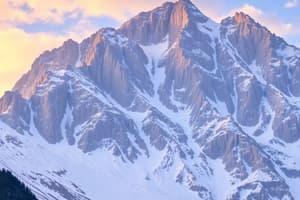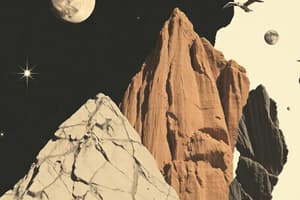Podcast
Questions and Answers
What is the main type of mountain formation responsible for the creation of the Himalayas?
What is the main type of mountain formation responsible for the creation of the Himalayas?
Fold mountains
What is the highest peak in the Himalayas, located on the Nepal-China border?
What is the highest peak in the Himalayas, located on the Nepal-China border?
Mount Everest
What are the three main divisions of the Himalayas?
What are the three main divisions of the Himalayas?
Greater Himalayas, Lesser Himalayas, and Shivalik Hills
What is the name of the valley located in Jammu and Kashmir, which includes the Jhelum River?
What is the name of the valley located in Jammu and Kashmir, which includes the Jhelum River?
What is the name of the tribe found in Sikkim and Darjeeling?
What is the name of the tribe found in Sikkim and Darjeeling?
What is the name of the lake located in Ladakh?
What is the name of the lake located in Ladakh?
What is the name of the mountain pass that connects Jammu and Kashmir to Ladakh?
What is the name of the mountain pass that connects Jammu and Kashmir to Ladakh?
What is the name of the river that originates in Tibet and flows through Assam?
What is the name of the river that originates in Tibet and flows through Assam?
What is the name of the highest range in the Himalayas, with peaks above 8,000m?
What is the name of the highest range in the Himalayas, with peaks above 8,000m?
What is the name of the mountain range that includes the Dhauladhar and Pirpanjal Ranges?
What is the name of the mountain range that includes the Dhauladhar and Pirpanjal Ranges?
Flashcards are hidden until you start studying
Study Notes
Types of Mountains
- The three main types of mountains are:
- Fold mountains - formed by the compression and folding of Earth's crust (e.g. Himalayas, Andes, Alps)
- Block mountains - formed by fault blocks that have been pushed up (e.g. Vosges, Black Forest)
- Volcanic mountains - formed by the eruption and solidification of lava (e.g. Mt. Kilimanjaro, Mt. Fuji)
Formation of the Himalayas
- The Himalayas were formed by the collision of the Indian and Eurasian tectonic plates around 50 million years ago
- As the Indian plate moved northward, it collided with and was pushed under the lighter Eurasian plate, causing the crust to buckle and fold upwards
- This formed a series of mountain ranges, with the highest being the Greater Himalayas or Himadri
- The Himalayas consist of several parallel ranges:
- Highest is the Greater Himalayas (Himadri) with average height of 6000m
- Middle Himalayas (Himachal or Lesser Himalayas) with average height of 4000m
- Outer Himalayas (Shivalik Range)
Key Himalayan Peaks
- The highest peak is Mount Everest (8,848m) located on the Nepal-China border
- Other major peaks include:
- K2 (8,611m) in the Karakoram Range
- Kanchenjunga (8,586m) in the Eastern Himalayas
- Nanda Devi (7,816m) in Uttarakhand, India
- Dhaulagiri (8,167m) and Annapurna (8,091m) in NepalHere are the study notes for the text:
Himalayan Divisions
- The Himalayas can be divided into three parts:
- Greater Himalayas
- Lesser Himalayas
- Shivalik Hills
Regional Divisions of Himalayas
- The Himalayas can be divided into regions:
- Kashmir Himalayas
- Himachal Himalayas
- Uttarakhand Himalayas
- Nepal Himalayas
- Assam Himalayas
- Eastern Himalayas (includes Darjeeling and Sikkim)
Sub-Regions of Himalayas
- Kashmir Himalayas:
- Includes Doda, Pirpanjal, and Zanskar Ranges
- Himachal Himalayas:
- Includes Dhauladhar and Pirpanjal Ranges
- Uttarakhand Himalayas:
- Includes Kumaon and Garhwal Ranges
- Nepal Himalayas:
- Includes Langtang, Ganesh, and Manaslu Ranges
- Assam Himalayas:
- Includes Eastern Himalayas, including Darjeeling and Sikkim
- Eastern Himalayas:
- Includes Arunachal Pradesh, Nagaland, and Manipur
Mountain Ranges
- Greater Himalayas:
- Highest and oldest range, with peaks above 8,000m
- Includes Mount Everest, Kangchenjunga, and Annapurna
- Lesser Himalayas:
- Middle range, with peaks between 3,000m to 6,000m
- Includes Dhauladhar, Pirpanjal, and Zanskar Ranges
- Shivalik Hills:
- Youngest and lowest range, with peaks below 3,000m
- Includes foothills of the Himalayas
Valleys and Rivers
- Kashmir Valley:
- Located in Jammu and Kashmir
- Includes the Jhelum River
- Kumaon Valley:
- Located in Uttarakhand
- Includes the Kali River
- Nepal Valley:
- Located in Nepal
- Includes the Ganges River
- Assam Valley:
- Located in Assam
- Includes the Brahmaputra River
Tribes and Ethnic Groups
- Bhutia Tribe:
- Found in Sikkim and Darjeeling
- Lepcha Tribe:
- Found in Sikkim and Darjeeling
- Monpa Tribe:
- Found in Arunachal Pradesh
- Mishmi Tribe:
- Found in Arunachal Pradesh
- Naga Tribe:
- Found in Nagaland
Lakes and Rivers
- Dal Lake:
- Located in Kashmir Valley
- Wular Lake:
- Located in Kashmir Valley
- Pangong Lake:
- Located in Ladakh
- Brahmaputra River:
- Originates in Tibet and flows through Assam
- Ganges River:
- Originates in Uttarakhand and flows through Nepal and India
Mountain Passes
- Banihal Pass:
- Connects Jammu and Kashmir to Ladakh
- Pir Panjal Pass:
- Connects Jammu and Kashmir to Ladakh
- Banihal Pass:
- Connects Jammu and Kashmir to Ladakh
- Rohtang Pass:
- Connects Himachal Pradesh to Ladakh
- Shipki La Pass:
- Connects Himachal Pradesh to Tibet
- Lipulekh Pass:
- Connects Uttarakhand to Tibet
- Nathu La Pass:
- Connects Sikkim to Tibet
Note: These notes are a summary of the key points from the original text and are not a direct translation.
Types of Mountains
- Three main types of mountains: Fold, Block, and Volcanic
- Fold mountains formed by compression and folding of Earth's crust (e.g. Himalayas, Andes, Alps)
- Block mountains formed by fault blocks pushed up (e.g. Vosges, Black Forest)
- Volcanic mountains formed by eruption and solidification of lava (e.g. Mt. Kilimanjaro, Mt. Fuji)
Himalayan Formation
- Himalayas formed by collision of Indian and Eurasian tectonic plates around 50 million years ago
- Indian plate moved northward, colliding with and pushed under Eurasian plate, causing crust to buckle and fold upwards
- Formed series of mountain ranges, with highest being the Greater Himalayas or Himadri
Himalayan Divisions
- Three parts: Greater Himalayas, Lesser Himalayas, and Shivalik Hills
- Regional divisions: Kashmir Himalayas, Himachal Himalayas, Uttarakhand Himalayas, Nepal Himalayas, Assam Himalayas, Eastern Himalayas
Key Himalayan Peaks
- Highest peak: Mount Everest (8,848m) on Nepal-China border
- Other major peaks: K2 (8,611m) in Karakoram Range, Kanchenjunga (8,586m) in Eastern Himalayas, Nanda Devi (7,816m) in Uttarakhand, India, Dhaulagiri (8,167m) and Annapurna (8,091m) in Nepal
Regional Divisions of Himalayas
- Kashmir Himalayas: includes Doda, Pirpanjal, and Zanskar Ranges
- Himachal Himalayas: includes Dhauladhar and Pirpanjal Ranges
- Uttarakhand Himalayas: includes Kumaon and Garhwal Ranges
- Nepal Himalayas: includes Langtang, Ganesh, and Manaslu Ranges
- Assam Himalayas: includes Eastern Himalayas, including Darjeeling and Sikkim
- Eastern Himalayas: includes Arunachal Pradesh, Nagaland, and Manipur
Mountain Ranges
- Greater Himalayas: highest and oldest range, with peaks above 8,000m
- Lesser Himalayas: middle range, with peaks between 3,000m to 6,000m
- Shivalik Hills: youngest and lowest range, with peaks below 3,000m
Valleys and Rivers
- Kashmir Valley: located in Jammu and Kashmir, includes Jhelum River
- Kumaon Valley: located in Uttarakhand, includes Kali River
- Nepal Valley: located in Nepal, includes Ganges River
- Assam Valley: located in Assam, includes Brahmaputra River
Tribes and Ethnic Groups
- Bhutia Tribe: found in Sikkim and Darjeeling
- Lepcha Tribe: found in Sikkim and Darjeeling
- Monpa Tribe: found in Arunachal Pradesh
- Mishmi Tribe: found in Arunachal Pradesh
- Naga Tribe: found in Nagaland
Lakes and Rivers
- Dal Lake: located in Kashmir Valley
- Wular Lake: located in Kashmir Valley
- Pangong Lake: located in Ladakh
- Brahmaputra River: originates in Tibet and flows through Assam
- Ganges River: originates in Uttarakhand and flows through Nepal and India
Mountain Passes
- Banihal Pass: connects Jammu and Kashmir to Ladakh
- Pir Panjal Pass: connects Jammu and Kashmir to Ladakh
- Rohtang Pass: connects Himachal Pradesh to Ladakh
- Shipki La Pass: connects Himachal Pradesh to Tibet
- Lipulekh Pass: connects Uttarakhand to Tibet
- Nathu La Pass: connects Sikkim to Tibet
Studying That Suits You
Use AI to generate personalized quizzes and flashcards to suit your learning preferences.



